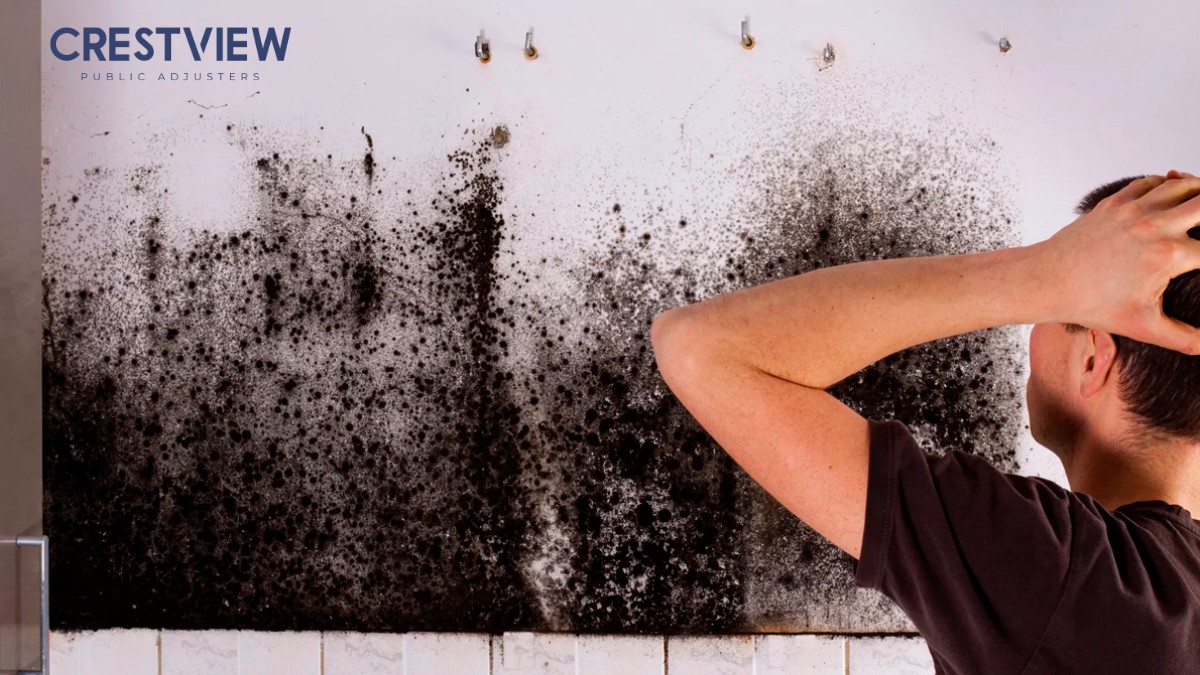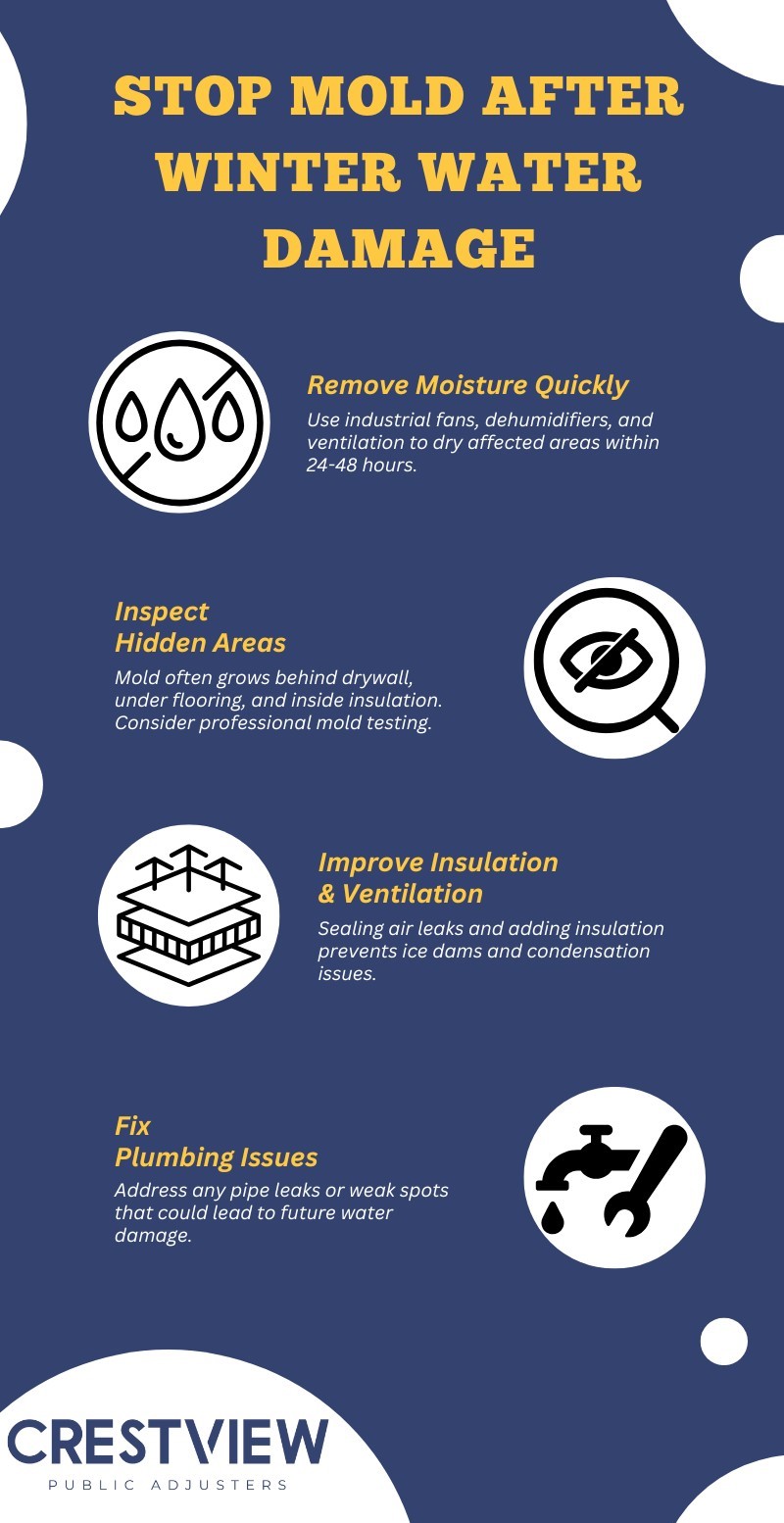Key Points:
- Mold growth from winter water damage is a major concern for homeowners, often caused by ice dams, burst pipes, and snowmelt leaks.
- Insurance coverage for mold varies—some policies include it, while others require additional endorsements or proof of a sudden and accidental cause.
- Proper documentation and professional public adjusters can maximize your claim, ensuring fair compensation for mold remediation and repairs.
You can file insurance claims for mold growth after winter water damage, but approval depends on your policy’s coverage. Homeowners insurance typically covers mold if it results from sudden and accidental water damage, such as a burst pipe or ice dam leak. However, if mold develops due to long-term neglect, gradual leaks, or humidity issues, insurers may deny your claim. Reviewing your policy’s mold coverage and acting quickly is crucial to securing compensation.
How Does Winter Water Damage Lead to Mold Growth?
Winter conditions create the perfect storm for mold growth, especially when water damage is left unaddressed. As snow and ice accumulate, they can seep into homes through various weak points. Once moisture enters, mold spores can colonize within 24 to 48 hours, particularly in areas with poor ventilation and insulation.
The most common winter-related water damage sources include:
- Ice dams: When snow melts on a warm roof but refreezes at the eaves, water backs up under shingles, leaking into the attic and walls.
- Burst pipes: Freezing temperatures can cause pipes to crack or burst, flooding walls, ceilings, and flooring with moisture.
- Snowmelt leaks: Heavy snowfall followed by sudden warm temperatures can cause foundation leaks, attic water damage, or basement flooding.
If left untreated, these water intrusions create damp conditions that accelerate mold growth, posing serious health risks and structural concerns.
Does Homeowners Insurance Cover Mold from Winter Water Damage?
Whether homeowners insurance covers mold after winter water damage depends on the cause of the damage and your policy’s terms.
When Mold is Covered
Insurance will likely cover mold remediation if the damage results from a sudden and accidental water event, such as:
- A burst pipe due to freezing temperatures
- An ice dam that forces water into your home
- A broken water heater caused by extreme cold
When Mold is Not Covered
Insurers typically deny mold claims if the growth results from:
- Long-term leaks or humidity problems
- Poor home maintenance or delayed repairs
- Flooding (unless you have a separate flood insurance policy)
Check your policy for mold exclusions—some insurers offer mold endorsements that extend coverage for an additional premium.

How to File an Insurance Claim for Mold After Winter Water Damage
Filing an insurance claim for mold growth requires thorough documentation and swift action. Here’s how to navigate the process effectively:
- Act Immediately – Report water damage to your insurer as soon as possible. Mold can spread quickly, so delaying could hurt your claim.
- Document Everything – Take photos and videos of the damage, including visible mold growth, water sources, and affected areas.
- Mitigate Further Damage – Follow your policy’s requirements by drying affected areas and preventing mold spread. Failure to act could lead to claim denial.
- Obtain Professional Assessments – Hire mold remediation specialists or public adjusters to assess the extent of damage and provide repair estimates.
- Submit a Detailed Claim – Provide a written statement describing the incident, along with all collected evidence.
- Negotiate with the Insurer – Insurance adjusters may try to minimize payouts—having a public adjuster on your side can help maximize your settlement.
How Can Public Adjusters Help with Mold Insurance Claims?
A public adjuster works for you, not the insurance company. They handle the complexities of your claim, ensuring you receive fair compensation for mold remediation and structural repairs. Here’s how they can help:
- Policy Review & Interpretation – Identifying coverage gaps and negotiating on your behalf.
- Damage Assessment – Conducting independent inspections to determine the true extent of mold damage.
- Claim Negotiation – Fighting for a higher settlement, especially if your insurer undervalues the damage.
With mold removal costs averaging between $1,500 and $6,000—and potentially much more if structural repairs are needed—having a public adjuster can mean the difference between a denied claim and full reimbursement.
Preventing Mold After Winter Water Damage
Even if you secure insurance compensation, preventing future mold problems is essential. After winter water damage, follow these steps to protect your home:

Get Expert Help for Your Mold Insurance Claim
If you’re struggling with insurance claims for mold growth after winter water damage, don’t navigate it alone. Crestview’s expert public adjusters specialize in securing maximum compensation for homeowners in New York, New Jersey, and Florida.
We ensure insurers honor their policies, helping you recover the full cost of mold remediation and repairs. Don’t settle for less—contact Crestview today and protect your home investment.

